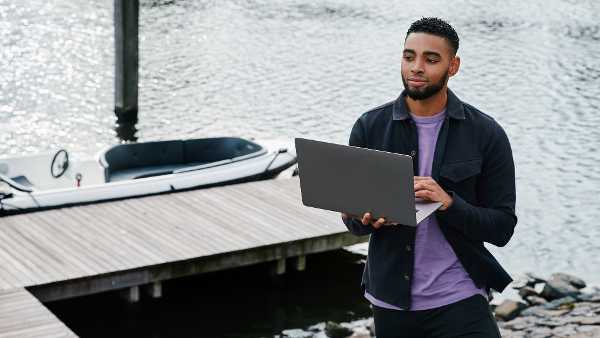Make your website accessible to all visitors

- Frances Gallimore
- Edited 13 June 2025
- 4 min
- Managing and growing
- Marketing
Some 2 million people in the Netherlands live with a disability. For example, limited mobility or a visual or auditory impairment. Others find it difficult to understand online information. With the right adaptations, you can make sure everyone can use your website easily and avoid missing out on potential customers. Read what rules there are and tips to improve your website.
Why an accessible website is important
Your business misses out on potential customers if your website is not accessible. Suppose a visually impaired visitor wants to buy a product on your website. This customer likes to use keyboard shortcuts because searching through a menu on the screen takes more effort and energy. If you can only use a mouse to click through the menu or pages on your website, your visitor might get lost. And chances are that the customer will leave your website without buying anything.
Do you sell products or services through a website or app? Also, do you have more than 10 employees and is your turnover more than €2 million? Then your website must be accessible to . This is stated in the European Accessibility Act, which took effect in June 2025.
Accessible websites rank better in search engines
Accessibility is not only important for your visitors. Search engines (such as Google and Bing) and AI tools (like ChatGPT and Gemini) also find accessible (in Dutch) easier to “read”. That means a better ranking in search results. And that, in turn, means more clicks on your website.
The rules for accessibility
Kristian Mul is a product manager for Digitoegankelijk, a Dutch government organisation promoting digital accessibility. She recommends following the WCAG standard. “These guidelines outline accessibility requirements for web content. Website visitors should be able to perceive all information and components on a website. Examples of accessibility rules:
- Add alternative text to images
- Make sure videos have subtitles
- Use clear buttons and links
"Making your website accessible takes time, but also pays off. So, get started right away," says Mul.
Help and tools for an accessible website
You need to know what your website is and is not doing right before you can improve it. The following tools can help you figure this out:
- Take the self-scan (in Dutch) developed by thuiswinkel.org to assess the accessibility of your online shop.
- Follow the Digitoegankelijk.nl (in Dutch) to make sure you meet all web accessibility requirements.
Tips per target audience
Every type of disability needs a specific solution to improve accessibility. Mul shares tips on catering to different types of visitors.
Visitors with physical disabilities
1.6 million people in the Netherlands have a physical . (in Dutch) This means they may find it difficult to type or operate a mouse very quickly, for example.
- Give visitors big buttons to click in order to browse the website or website menu.
- Allow users to browse your website with voice commands rather than typing by installing text-to-speech software.
- Make sure the mouse (in Dutch) on your website works properly. Visitors with visual impairments can then use the same system, using keyboard shortcuts instead.
- If a user makes a mistake when filling in a form, trigger a clear error message. This will tell the user that the information has not been submitted yet and which field(s) they must still complete.
Visitors with hearing problems
More than 2 million people in the Netherlands are deaf or (in Dutch). Here is what you can do for them:
- Add subtitles to your videos so that visitors can read along. You can also include a sign language interpreter to translate speech into sign language.
- Use short sentences and easy words. People who communicate in sign language use a different grammar, so written language may not be easy for them to understand.
- Provide transcriptions of audio files, like podcasts.
- Allow visitors to switch sound on and off.
Visually impaired, colour blind, or blind visitors
Around 300,000 Dutch people have a visual impairment. Here is what you can do for them:
- Use contrasting colours, like black letters on an orange background, instead of white letters. The bigger the difference, the better.
- Allow visitors to adjust the font size. Digital information can be (in Dutch) up to 32 times. For this to be possible, your websites and apps have to be coded properly and support magnification devices.
- Underline hyperlinks to make them easier for colour-blind people to recognise.
- Code your website so that it can be read out loud by special voice reader software. Make sure that all the information conveyed by colours, shapes, or images is also put into . (in Dutch) Create a written description of images and infographics, so that the information can be read out loud by software. Images should always have a clear file name and alt text. Voice reader software reads out information about images, like the file name, and general names like ‘image 123’ are of little use to blind people. Meaningful file names and alt texts like 'photo toothpaste extra white 75 ml' are much better.
- Symbols like check marks and emojis should also be accompanied by alternative texts. Remember that identical symbols can have different meanings. You might use two different check marks to convey different messages, for instance.
- Blind people often use a braille (in Dutch). This is a special keyboard that can be connected to a PC, laptop, or tablet and converts on-screen text to braille (and vice versa). Avoid vague hyperlinks like 'click here' and opt for a description like 'read more about toothpaste for sensitive teeth' instead. This will tell blind users what to expect.
Visitors who struggle with processing digital information
Some visitors find it difficult to understand online information. They may be relatively new to the internet, for instance, or not often online. Tips on making information easier to understand:
- If there are hyperlinks in your texts, tell users exactly where they will end up after clicking on the link. A hyperlink like 'discover the 7 steps' is easier to understand than 'click here'.
- Use short sentences and easy words.
- Add images to descriptions and product information. Visitors can then choose what works best for them.
- Allow visitors to turn off moving or flashing content or background noise.
If these tips are too technical for you, contact a website builder for help.
Ask for feedback
"Invite visitors to share their experience and feedback with you. That way, you can keep working on the accessibility of your website," Mul advises.


